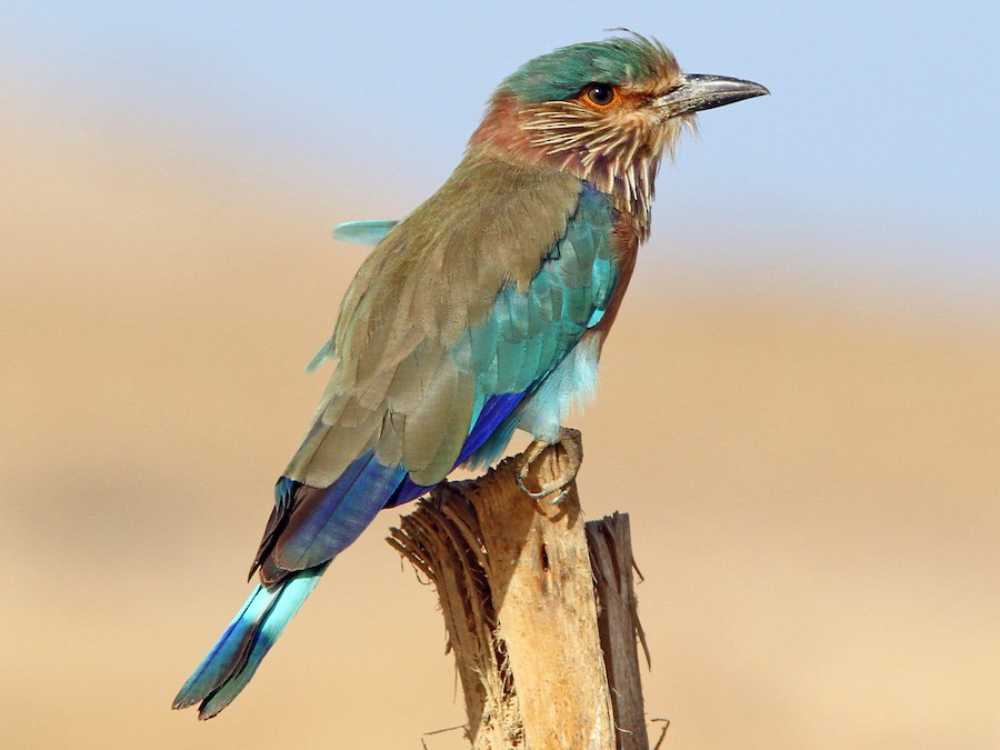Taxonomy and Distribution
The Indian Roller, also known as the Blue Jay or the Blue Jay Roller, belongs to the roller family (Coraciidae) and is native to the Indian subcontinent, extending from Afghanistan to the Indian peninsula, and across into Southeast Asia. Its range covers a diverse array of habitats, including open woodland, farmland, grassland, and urban areas.
Physical Characteristics
At first glance, the Indian Roller appears like a living canvas painted in vibrant hues. Its most distinctive feature is its striking blue plumage, which spans the head, wings, and tail. This iridescent blue is accented by flashes of violet and turquoise, creating a spectacle of color that captivates onlookers.
The bird’s wings, when folded, reveal a patch of bright azure contrasting against the darker hues, reminiscent of a hidden treasure waiting to be discovered. In flight, the contrasting patterns of blue and black create a mesmerizing display against the sky.
While its plumage steals the spotlight, the Indian Roller possesses other notable physical traits. Its stout bill, curved at the tip, is well-suited for catching insects mid-flight, its primary source of food. The bird’s relatively large size, measuring around 25-27 centimeters in length, adds to its commanding presence.

Behavior and Ecology
Indian Rollers are diurnal creatures, meaning they are most active during the day. Their flight is a sight to behold, characterized by swift, elegant movements punctuated by sudden dives and rolls, hence their name. During the breeding season, males perform elaborate aerial displays to attract mates, showcasing their agility and prowess.
These birds are primarily insectivorous, preying on a variety of insects, including grasshoppers, beetles, and caterpillars. Their hunting technique involves perching on a high vantage point, such as a tree branch or utility wire, before swooping down to catch prey in mid-air. This aerial hunting prowess makes them valuable allies to farmers, helping control pest populations in agricultural areas.
Indian Rollers are monogamous during the breeding season, forming strong pair bonds. Nesting typically occurs in tree hollows or crevices, where the female lays a clutch of eggs. Both parents share responsibilities in incubating the eggs and caring for the hatchlings.
Cultural Significance
Beyond its ecological importance, the Indian Roller holds a special place in Indian culture and folklore. In Hindu mythology, the bird is associated with Garuda, the legendary bird mount of Lord Vishnu, symbolizing strength, speed, and freedom. Its vibrant plumage and graceful flight have inspired artists, poets, and storytellers for centuries, appearing in traditional paintings, poetry, and folk tales.
In some regions of India, the sighting of a Roller is considered auspicious, believed to bring good fortune and prosperity. Conversely, harming these birds is often viewed as an ill omen, with superstitions cautioning against disturbing their nests or harming them in any way.
Conservation Status
Despite its cultural significance and widespread distribution, the Indian Roller faces various threats to its survival. Habitat loss due to urbanization, agriculture, and deforestation poses a significant challenge, depriving these birds of nesting sites and foraging grounds. Additionally, pesticide use in agriculture can indirectly harm rollers by reducing insect populations, their primary food source.
While not currently listed as globally threatened, the Indian Roller’s population trends are declining in some regions, warranting conservation attention. Efforts such as habitat restoration, the creation of protected areas, and raising awareness about the bird’s ecological importance are essential for ensuring its long-term survival.
Conclusion
The Indian Roller stands as a testament to the beauty and diversity of India’s avian fauna. With its stunning plumage, aerial acrobatics, and cultural significance, this magnificent bird captures the imagination of all who encounter it. As stewards of the natural world, it is our responsibility to safeguard the habitats and ecosystems that support the Indian Roller and ensure that future generations can continue to marvel at its splendor.









